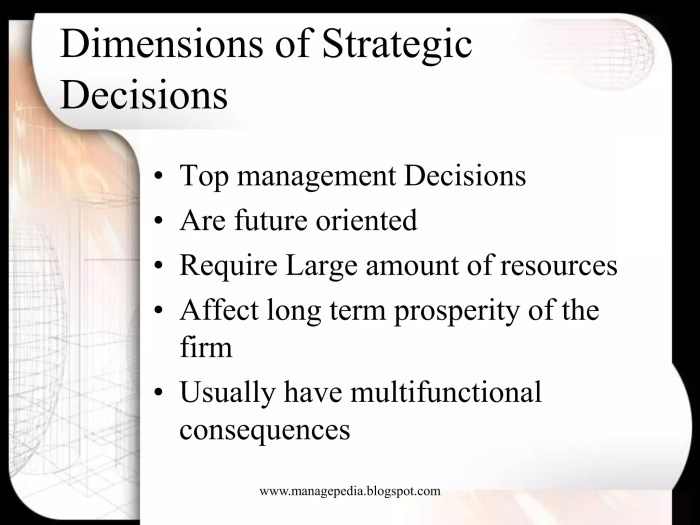
In the fast-paced world of business, understanding the intricacies of strategic decision-making models is crucial for success. These models not only provide a framework for making informed choices but also help organizations navigate complex challenges and seize opportunities. By integrating various components and phases into the decision-making process, businesses can enhance their branding and growth strategies.
This exploration delves into the significance of strategic decision-making models, showcasing their application across various industries and highlighting how they can transform financial management and profitability. From popular models to practical applications, this discussion aims to equip you with the knowledge to leverage these tools effectively.
Strategic Decision-Making Models Overview

Strategic decision-making models are essential frameworks that assist organizations in navigating complex business environments. They provide structured approaches to identify, analyze, and select the best actions to achieve long-term objectives. By employing these models, businesses can improve their decision-making processes and optimize resource allocation, ultimately leading to better outcomes.Strategic decision-making encompasses several key components and phases. Initially, it involves recognizing the need for a decision, followed by gathering relevant information and analyzing alternatives.
Once options are evaluated, the decision is made, and the final phase involves monitoring outcomes and making adjustments as necessary.
Key Components and Phases of Strategic Decision-Making
Understanding the components and phases of strategic decision-making can significantly enhance the effectiveness of business strategies. The following points Artikel these crucial elements:
- Problem Identification: Recognizing the issue that requires a strategic decision is the first step in the process.
- Information Gathering: Collecting relevant data and insights that can aid in the decision-making process, such as market analysis and competitor research.
- Evaluation of Alternatives: Analyzing different strategic options, weighing their potential risks and benefits to identify the most suitable choice.
- Decision Implementation: Executing the chosen strategy requires careful planning and resource allocation to ensure successful application.
- Monitoring and Review: Continuously assessing the outcomes of the decision to determine its effectiveness and making necessary adjustments.
Popular Strategic Decision-Making Models
Several strategic decision-making models are widely adopted across various industries, each offering unique approaches to navigating complexities. These models provide valuable insights and frameworks for organizations to follow.
- SWOT Analysis: This model focuses on identifying internal Strengths and Weaknesses, along with external Opportunities and Threats, providing a comprehensive overview of the strategic landscape.
- Porter’s Five Forces: This framework helps analyze the competitive environment by assessing the bargaining power of suppliers and customers, the threat of new entrants, the threat of substitutes, and industry rivalry.
- Balanced Scorecard: This model translates an organization’s strategic objectives into a set of performance measures, enabling leaders to monitor performance across different business areas.
- Ansoff Matrix: This strategic tool assists businesses in determining growth strategies by evaluating options based on market penetration, market development, product development, and diversification.
- PESTLE Analysis: A framework that examines external factors affecting an organization, including Political, Economic, Social, Technological, Legal, and Environmental aspects.
These models are not just theoretical concepts but are actively used by successful organizations to drive strategic initiatives and respond to dynamic market conditions. Implementing strategic decision-making models fosters a structured approach, enhancing clarity and focus in the decision-making process.
Application of Strategic Decision-Making Models in Business
Strategic decision-making models serve as essential frameworks that guide organizations in making informed choices that can significantly impact their branding, business development, and growth strategies. By applying these models, businesses can navigate complex environments, optimize resource allocation, and enhance their competitive advantage.The influence of strategic decision-making models on branding is profound. These models assist companies in identifying their core values, target audiences, and market positioning.
By leveraging these insights, businesses can create a strong, consistent brand message that resonates with consumers. For example, a company like Apple employs strategic decision-making models to maintain its distinct brand identity, ensuring that all its products align with its innovation and quality ethos.
Influence on Branding
Strategic decision-making models help in shaping branding strategies by analyzing market trends, consumer behavior, and competitive landscapes. The following points illustrate the mechanisms through which these models influence branding:
- Market Segmentation: Models like the STP (Segmentation, Targeting, Positioning) framework allow businesses to define their audience and tailor branding strategies that meet specific needs.
- Value Proposition Development: Strategic models guide the formulation of unique value propositions that differentiate brands in competitive markets.
- Brand Equity Assessment: Decision-making frameworks enable businesses to evaluate brand equity and make adjustments to strengthen brand loyalty.
- Communication Strategy: Utilizing models assists in creating effective communication strategies that align with brand values and consumer expectations.
The role of strategic decision-making models extends to business development and growth strategies. These models empower organizations to analyze their current positions and forecast future opportunities. By employing various frameworks such as SWOT (Strengths, Weaknesses, Opportunities, Threats) and BCG (Boston Consulting Group) Matrix, companies can identify areas for expansion, investment, or divestment.
Role in Business Development and Growth
The application of strategic decision-making models in business development allows organizations to pinpoint growth strategies that are both actionable and sustainable. The following aspects highlight their significance:
- Resource Allocation: Strategic models guide companies on how to allocate resources efficiently to maximize returns on investment.
- Risk Assessment: They provide tools for evaluating risks associated with different growth strategies, allowing businesses to make informed decisions.
- Performance Monitoring: These models help in establishing KPIs (Key Performance Indicators) that monitor the effectiveness of growth initiatives.
- Market Entry Strategies: Decision-making frameworks assist in determining optimal market entry strategies, whether through joint ventures, acquisitions, or organic growth.
A comparison chart of different strategic decision-making models can help businesses evaluate their effectiveness in various contexts. This comparison Artikels their specific applications and advantages:
| Model | Application | Effectiveness |
|---|---|---|
| SWOT Analysis | Identifying internal and external factors that affect an organization | Highly effective for strategic planning and resource allocation |
| BCG Matrix | Evaluating product portfolio based on market growth and market share | Useful for portfolio management and investment decisions |
| PESTLE Analysis | Assessing external macro-environmental factors | Effective for understanding market dynamics and risks |
| Porter’s Five Forces | Analyzing industry competition and profit potential | Excellent for competitive strategy development |
The insights derived from these strategic models are invaluable for businesses looking to enhance their decision-making processes, improve branding, and foster sustainable growth.
The Impact of Strategic Decision-Making on Financial Management
Strategic decision-making significantly influences financial management, directly affecting a business’s ability to allocate resources efficiently and enhance profitability. By applying strategic decision-making models, organizations can better navigate complex financial landscapes and make informed decisions that align with their long-term goals. This results in improved financial practices that bolster overall business performance.Effective strategic decision-making models enhance business accounting practices through the integration of financial forecasting, budgeting, and performance analysis.
These models allow companies to assess potential financial impacts before implementing major decisions, leading to more accurate financial reporting and improved compliance with regulatory standards. By utilizing data analytics and scenario planning, businesses can gain insights into their financial health, enabling them to identify trends and make adjustments proactively.
Alignment of Financial Strategies with Business Management
Aligning financial strategies with overall business management is crucial for achieving desired outcomes. This alignment ensures that financial resources are directed toward initiatives that support the organization’s strategic objectives. The following points illustrate the key aspects of this alignment:
- Resource Allocation: Strategic decision-making models facilitate the prioritization of investments, ensuring that financial resources are allocated to areas with the highest potential for growth and return on investment.
- Risk Management: By integrating financial strategies into the overall strategic framework, businesses can better identify, assess, and mitigate financial risks, protecting their assets and ensuring sustainability.
- Performance Measurement: Strategic financial models provide metrics for evaluating business performance, enabling organizations to track progress toward financial goals and make necessary adjustments promptly.
- Cost Control: Implementing strategic decision-making allows for improved cost management, helping businesses identify inefficiencies and reduce waste, thus driving profitability.
The relationship between strategic decision-making and business profitability can be effectively illustrated through the following table:
| Strategic Decision-Making Aspect | Impact on Profitability |
|---|---|
| Investment Decisions | Informed investments can lead to higher returns and increased market share. |
| Cost Management | Effective cost control measures enhance profit margins and sustain cash flow. |
| Risk Assessment | Proactive identification of risks mitigates potential financial losses, preserving profitability. |
| Financial Forecasting | Accurate forecasts support strategic planning, helping businesses anticipate market changes and adjust accordingly. |
Implementing strategic decision-making models yields significant benefits in financial management, allowing businesses to operate with greater efficiency and achieve stronger financial outcomes. By fostering a culture of strategic thinking, organizations can enhance their accounting practices and align financial strategies with their overall business objectives.
Outcome Summary

In conclusion, strategic decision-making models serve as vital instruments in shaping business outcomes and financial success. By comprehensively understanding and applying these models, organizations can refine their strategies and ensure sustained growth in a competitive landscape. This journey into decision-making excellence not only clarifies the path to better decisions but also underscores the importance of aligning strategies with overarching business goals.
FAQ Explained
What are strategic decision-making models?
They are frameworks used by businesses to guide their decision-making processes, ensuring informed and effective choices.
How can these models improve financial management?
By aligning financial strategies with business goals, they help optimize accounting practices and enhance profitability.
Why are these models important for branding?
They provide insights that can shape branding strategies, helping businesses create a strong market presence.
Can strategic decision-making models be adapted for different industries?
Yes, they can be tailored to fit the unique needs and challenges of various industries.
What are some examples of popular strategic decision-making models?
Examples include SWOT analysis, PESTLE analysis, and the Balanced Scorecard, among others.





